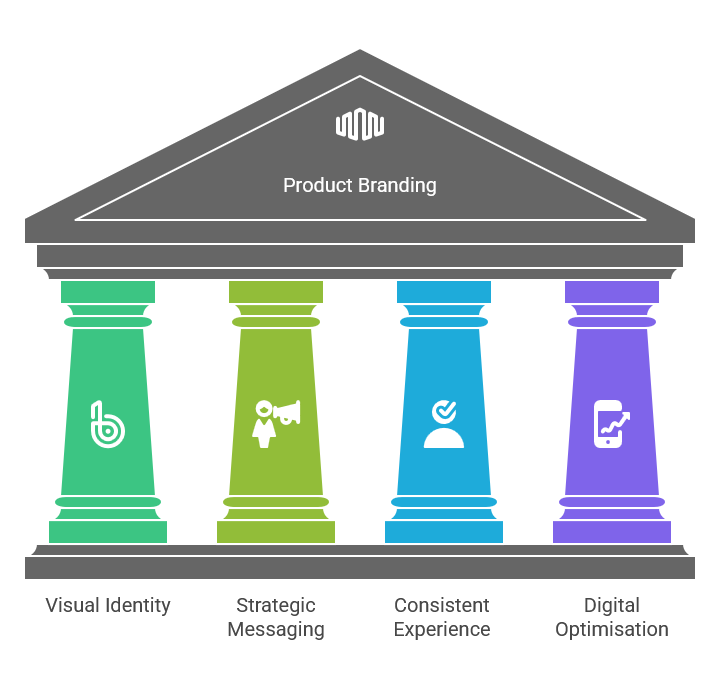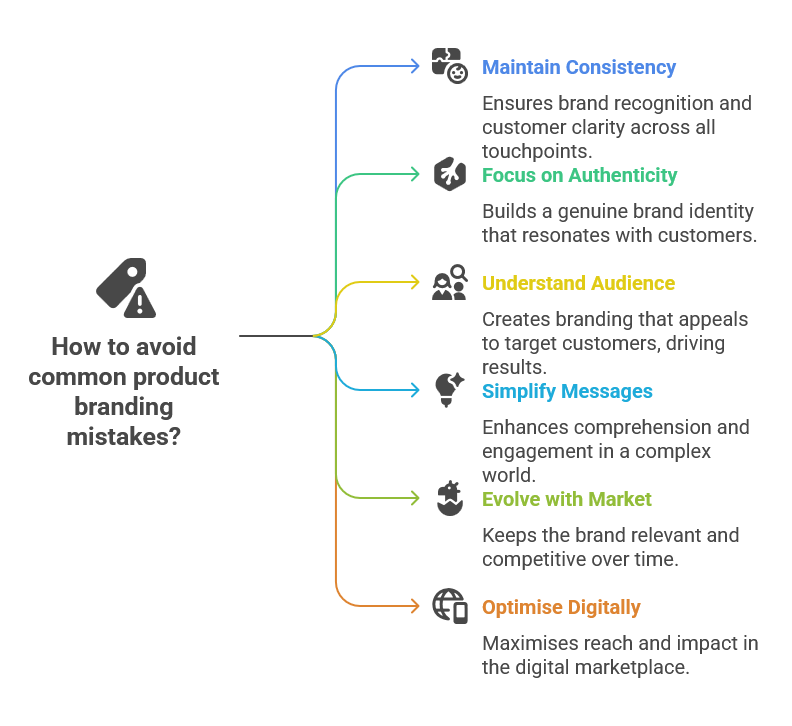Key Takeaways
- Product Branding is a Survival Strategy: In 2025's hypercompetitive marketplace, compelling brand identity is essential for cutting through noise and creating genuine customer connections.
- Emotional Connection Drives Results: Strong branding enables premium pricing, customer loyalty, and word-of-mouth marketing by moving beyond features to emotional bonds.
- Consistency Across Touchpoints: Visual identity, messaging, and customer experience must align across all platforms to build trust and recognition.
- Research-Driven Strategy Essential: Success requires deep audience understanding, competitive analysis, and clear brand personality definition before design execution.
- Avoid Common Pitfalls: Inconsistent implementation, trend-chasing over authenticity, and neglecting digital optimisation can derail branding efforts.
Introduction: The New Reality of Brand Competition
Welcome to 2025, where your product has about three seconds to make an impression before consumers move on to the next option.
Digital transformation has created a hypercompetitive marketplace where countless alternatives are just a click away, and consumers are more informed and demanding than ever.
In this environment, product branding isn't just marketing fluff – it's your survival strategy. The brands that thrive today understand that great products alone aren't enough. You need a compelling brand story that cuts through the noise and creates genuine connections with your audience.
What is the Meaning of Product Branding?
Product branding is the strategic process of creating a unique identity for your specific product or product line. Unlike corporate branding, which covers your entire company, product branding zeroes in on individual offerings to help them stand out from the competition.
Think of it as your product's personality. It encompasses everything from visual elements like logos and packaging to the emotional experience customers have when they interact with your product. Effective product branding transforms ordinary items into preferred choices that customers actively seek out and recommend to others.
The goal of branding your product?
To create an emotional connection that goes beyond features and price points. When customers feel connected to your brand, they become loyal advocates who choose you repeatedly and tell others about their positive experiences.
Why is Product Branding Design Important?
Several factors have elevated the importance of product branding design in 2025:
- Digital-First Shopping: Consumers now research and compare products online before making purchase decisions. Your branding design is often their first impression of your product, and you have mere seconds to capture their attention.
- Social Commerce Growth: Visual platforms like Instagram and TikTok have become major sales channels. Products with strong visual branding naturally perform better on these platforms, generating more engagement and user-generated content.
- Information Overload: With countless options available, consumers rely on visual cues to quickly filter through choices. Strong branding design helps your product stand out in crowded marketplaces.
- Authenticity Demands: Today's consumers scrutinise brands carefully, especially regarding sustainability and values. Your branding design must authentically reflect what your brand stands for to build trust.
Investing in product branding delivers measurable returns across multiple areas:
- Premium Pricing Power: Well-branded products can command significantly higher prices than generic alternatives. Customers willingly pay more for brands they trust and perceive as valuable.
- Customer Loyalty: Strong brands create emotional connections that foster repeat purchases. Loyal customers also become brand advocates, providing valuable word-of-mouth marketing that's more trusted than traditional advertising.
- Recognition and Recall: Distinctive branding makes your product instantly recognisable, improving recall when customers are ready to purchase. This recognition translates directly into increased sales and market share.
- Competitive Differentiation: In saturated markets, branding becomes your primary differentiator. Even if your product features are similar to competitors', strong branding positions you as the preferred choice.
- Marketing Efficiency: Established brands require less marketing investment to generate awareness and sales. Your branding does the heavy lifting in communicating value and building trust.
Essential Product Branding Elements That Drive Success

Creating compelling product branding requires orchestrating several key elements:
- Visual Identity: Your logo, colour palette, typography, and imagery should work together to create instant recognition and convey your brand personality. These elements must be distinctive yet appropriate for your target audience.
- Strategic Messaging: Your brand voice, tone, and key messages must clearly communicate your unique value while resonating emotionally with your audience. Focus on the benefits that matter most to your customers.
- Consistent Experience: Every customer touchpoint – from packaging to social media to customer service – must reinforce the same brand promise. Consistency builds trust and recognition over time.
- Digital Optimisation: Ensure your branding works effectively across all digital platforms, from your website to social media profiles. Mobile optimisation is particularly crucial as most consumers browse on their phones.
Read more: From Packaging to Positioning: A Complete Product Branding Checklist
Product Branding Strategies For Enhancing Your Brand
Developing effective product branding requires a systematic approach:
- Start with Research: Understanding your target audience is fundamental. What are their needs, preferences, and pain points? What emotional triggers influence their purchasing decisions? Use this insight to guide all branding decisions.
- Analyse the Competition: Study your competitors to identify gaps and opportunities for differentiation. The goal isn't to copy what works but to find your own unique positioning.
- Define Your Personality: If your product could speak, what would it sound like? Developing a clear brand personality helps guide design decisions and ensures consistency across all communications.
- Focus on Emotion: Move beyond functional benefits to create emotional connections. People buy products that make them feel good about themselves and their choices.
- Tell Your Story: Craft compelling narratives around your product that resonate with your audience's values and aspirations. Stories are more memorable than feature lists and create deeper connections.
- Integrate Sustainability: Environmental and social responsibility must be embedded in your core brand strategy, not added as an afterthought. This is non-negotiable for today's conscious consumers.
Read more: Branding Strategies for Malaysian Brands
Common Product Branding Mistakes to Avoid
Avoid these pitfalls that can derail even well-intentioned branding efforts:
- Inconsistent Implementation: When your branding varies across touchpoints, it confuses customers and dilutes recognition. Maintain strict brand guidelines and ensure all team members follow them.
- Trend-Chasing Over Authenticity: Following every design trend creates superficial branding that lacks substance. Focus on the authentic expression of your brand values rather than copying what's popular.
- Ignoring Your Audience: Creating branding that appeals to internal stakeholders rather than target customers leads to beautiful work that fails to drive results. Always validate decisions against customer research.
- Overcomplicating Messages: In an era of information overload, complexity kills comprehension. Keep your brand message simple, clear, and easy to understand.
- Forgetting About Brand Evolution: Neglecting to update your brand will cause it to feel outdated. Successful products are those that continue to grow and evolve with shifting market conditions and audience perceptions while still maintaining a consistent brand identity.
- Neglecting Digital Optimisation: Failing to ensure your branding works across digital platforms severely limits your reach in today's digital-first marketplace.

Product Branding Examples
Looking at successful examples provides valuable insights. At BikeBear, we've helped brands create compelling product identities:
POPO
For this beloved Malaysian snack brand, we tapped into nostalgia with the tagline "One Taste, A Thousand Memories." The branding emphasised POPO as a friendly, nostalgic brand using colours that complemented the Malaysian flag, creating an emotional connection with local consumers.
Ohsem Pasta
When this brand wanted to expand beyond pasta delivery, we simplified their approach by dropping "Pasta" from their logo. This small change opened endless possibilities, allowing "Ohsem" to represent all their delicious offerings.
These examples show how effective branding creates emotional connections while maintaining flexibility for future growth.
Why Partner with a Product Branding Consulting Agency?
While some businesses handle branding internally, partnering with specialised branding agencies offers significant advantages:
- Expertise and Perspective: Professional agencies bring deep knowledge across industries and understand current market dynamics and proven methodologies.
- Objective Viewpoint: External consultants provide unbiased perspectives and identify opportunities that internal teams might miss due to familiarity.
- Resource Efficiency: Agencies provide immediate access to senior talent and professional tools without the overhead of building internal capabilities.
- Speed to Market: Experienced agencies execute branding projects faster, helping you capitalise on market opportunities quickly.
Read more: Choosing the Right Branding Agency in Malaysia
Final Thoughts
Product branding has evolved from a marketing tactic to a strategic imperative. Success requires deep customer understanding, strategic differentiation, consistent execution, and authentic commitment to values that matter to your audience.
The brands winning in 2025 won't just be selling products – they'll be connecting with customers on a human level. Whether you're launching something new or revitalising an existing product, investing in strategic branding is essential for standing out in today's competitive marketplace.
Ready to transform your product through strategic branding?
Contact BikeBear's branding experts to discuss how we can help you create a product brand that drives results and builds lasting customer relationships.






